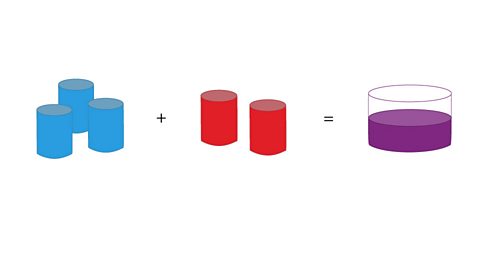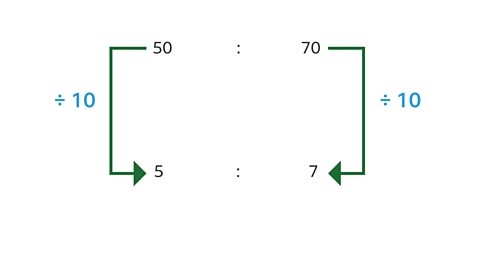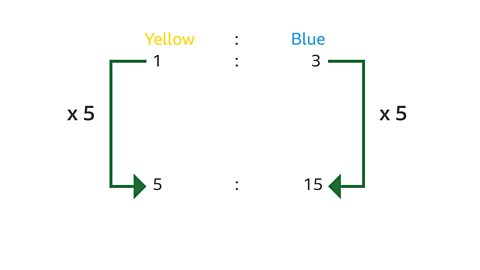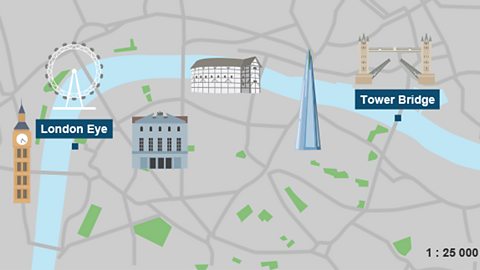How to write ratios
Ratios are used to compare two or more quantities and are usually written in the form a:b.
Purple paint is made from \(3\) parts blue paint and \(2\) parts red paint.

The ratio of blue paint to red paint can be written as \(3 : 2\)
It is important to write ratios in the correct order.
Make sure the numbers either side of the ratio symbol refer to the correct part.
Blue paint : Red paint -
\(3 : 2\)
or
Red paint : Blue paint -
\(2 : 3\)
Simplifying Ratios
In year \(10\) in a school there are \(50\) boys and \(70\) girls.
The ratio of boys to girls is \(50:70\)
This ratio can be simplified by dividing each part by the same number.

Both sides of the ratio can be divided by the same number to give an equivalent ratio in the simplest form.
We can say for every \(5\) boys there are \(7\) girls.
\(50:70 = 5:7\)
Question
Write the ratio \(40:28\) in its simplest form.
Answer
To work this out, look for a number that will divide into \(40\) and \(28\).
\(2\) divides into both numbers, so \(40:28\) can be written as \(20:14\).
You can divide these by \(2\), so the simplified ratio is \(10:7\).
No number divides into \(10\) and \(7\) exactly, so \(10:7\) is the simplest form of the ratio.
Or, you could divide \(40\) and \(28\) by the the highest common factor which in this case is \(4\).
This also results in the simplified ratio: \(10:7\).
Equivalent Ratios
If you are making orange squash and you mix one part orange to four parts water, then the ratio of orange to water will be \(1\) to \(4\) (\(1:4\)).
If you use \(1\) litre of orange, you will use \(4\) litres of water (\(1:4\)).
If you use \(100\) ml of orange, you will use \(400\) ml of water (\(100:400\)).
If you use \(200\) ml of orange, you will use \(800\) ml of water (\(200:800\)).
These ratios are all equivalent: \(1:4\) = \(100:400\) = \(200:800\)
Both sides of the ratio can be multiplied by the same number to give an equivalent ratio.
Question
In a bracelet for every yellow bead there are \(3\) blue beads.
How many blue beads will there be in a bracelet with \(5\) yellow beads?
Answer
Begin by writing the number of yellow beads to blue beads as a ratio.
Since the number of yellow beads has been multiplied by \(5\) the number of blue beads should also be multiplied by \(5\).

The bracelet will have \(5\) yellow beads and \(15\) blue beads.
How to divide a quantity into a given ratio
Ratios can be used to divide a quantity into parts.
To do this follow these \(3\) steps:
Find the total number of parts by adding the parts in each share.
Divide the amount by this total to find what \(1\) part is worth.
Multiply \(1\) part by the number of parts in each share to find each share.
Example
Dave, Lisa and Milo win \(ВЈ600\) between them.
They agree to divide the money in the ratio \(2:3:1\).
How much does each person receive?
- Find the total number of parts by adding the parts in each share.
Total parts - \(2+3+1 = 6\)
- Divide the amount by this total to find what \(1\) part is worth.
\(1\) Part is worth - \({ВЈ600}\div{6} = {ВЈ100}\)
- Multiply \(1\) part by the number of parts in each share to find the amount of the share.
Dave gets \(2\) parts - \({2}\times{100} = {ВЈ200}\)
Lisa gets \(3\) parts - \({3}\times{100} = {ВЈ300}\)
Milo gets \(1\) part - \({1}\times{100} = ВЈ100\)
Check that all the shares add up to the total amount \(ВЈ200 + ВЈ300 + ВЈ100 = ВЈ600~вњ“\)
Question
A necklace is made using gold and silver beads in the ratio \(3:2\). If there are \(80\) beads in the necklace:
How many are gold?
How many are silver?
Answer
Find the total number of parts by adding the parts in each share
Total parts - \(3+2 = 5\)
Divide the amount by this total to find what \(1\) part is worth.
\(1\) part is worth - \(80 Г· 5 = 16\)
Multiply \(1\) part by the number of parts in each share to find the amount of the share.
- Gold \(= 3Г—16 = 48\) beads.
- Silver \(= 2Г—16 = 32\) beads.
Check that all the shares add up to the total amount
How to find one share of a ratio given another
Sometimes we need to find an unknown quantity.
For example, juice is made from cordial and water in the ratio \(2:5\).
Sam has \(50\) ml of cordial, how much water should she add to make the juice if she uses all the cordial?
\(2\) parts = \(50\) ml
Find \(1\) part by dividing by \(2\)
\(1\) part = \(25\) ml
Find \(5\) parts by multiplying \(1\) part by \(5\)
\(5\) parts \(= 5Г—25 = 125\) ml
Sam should add \(125\) ml of water.
Question
Amelia and Louis win a sum of money, which they agree to share in the ratio \(5:3\).
If Amelia receives \(ВЈ150\), how much will Louis receive?
Answer
Amelia receives \(5\) parts.
\(5\) parts \(= ВЈ150\)
\(1\) part \(= ВЈ150 Г· 5 = ВЈ30\)
Louis receives \(3\) parts.
\(3\) parts \(= 3 Г— ВЈ30 = ВЈ90\)
Real life uses for ratio
Ratios are used in everyday life and can help you work out problems including models, scale drawings, plans and reading maps.
Key point
A ratio has no units.
Models
Question
A model boat is made to a scale of \(1:20\).
This scale can be applied to any units, so \(1\) mm measured on the model is \(20\) mm on the actual boat.
Similarly, \(1\) cm measured on the model is \(20\) cm on the actual boat.
a) If the model boat is \(15\) cm wide, how wide is the actual boat?
b) If the boat has a mast of height \(4\) m, how high is the mast on the model?
Answer
a) The scale is \(1:20\).
This means that every \(1\) cm on the model is equivalent to \(20\) cm on the boat.
The mathematical symbol for equivalent is: в‰Ў
\(1\) cm on the model \(в‰Ў 20\) cm on the boat.
So, because: \(15 Г— 20 = 300\)
\(15\) cm on the model \(в‰Ў 300\) cm (or \(3\) m) on the boat.
b) \(20\) cm on the boat \(в‰Ў 1\) cm on the model
So, because: \(4\) m \(= 400\) cm, and \(400 Г· 20 = 20\)
\(4\) m (or \(400\) cm) on the boat \(в‰Ў 20\) cm on the model.
Scale drawings and plans
Question
A plan of a classroom is drawn using a scale of \(1:50\).
a) If the width of the classroom on the plan is \(12\) cm, what is the actual width of the classroom?
The scale of \(1:50\).
This means that every \(1\) cm on the plan is the same as \(50\) cm in the actual classroom.
b) If the actual length of the classroom is \(11\) m, what length will it be on the plan?
Answers
(a) Since the width of the plan is \(12\)cm the actual width will be \({12}\times{50} = {600}\) cm.
\(600\) cm \(= 6\) m.
The actual width of the classroom is \(6\) m.
b) The actual length of the classroom is \(11\)m.
Change this into cm - \(11\) m \(= 1100\) cm.
\({1100}\div{50} = {22}\) cm
The length of the classroom on the plan is \(22\) cm.
Test section
Question 1
Which ratio is equivalent to \({2:3}\)?
a) \({4:7}\)
b) \({5:10}\)
c) \({6:9}\)
Answer
Multiplying or dividing both sides of the ratio by the same number gives an equivalent ratio.
Here, \({2:3}\) is multiplied by \({3}\) to give \({6:9}\).
Question 2
Which ratio is not equivalent to \({1:4}\)?
a) \({3:12}\)
b) \({4:14}\)
c) \({5:20}\)
Answer
The correct answer is: \({4:14}\).
Multiplying or dividing both sides of the ratio by the same number gives an equivalent ratio.
Here, \({1:4}\) is multiplied by \({3}\) to give \({3:12}\) and multiplied by \({5}\) to give \({5:20}\). \({1:4}\) multiplied by \({4}\) would give \({4:16}\), so \({4:14}\) is not an equivalent ratio.
Question 3
What is \({14:35}\) in its simplest form?
a) \({1:4}\)
b) \({1:5}\)
c) \({2:5}\)
Answer
Dividing both sides of the ratio by the highest common factor gives the ratio in its simplest form.
The highest common factor of \({14}\) and \({35}\) is \({7}\).
Both sides therefore need to be divided by \({7}\), so \({14:35}\div{7}={2:5}\).
Question 4
Alex and Sara share \(\pounds{600}\) in the ratio \({2:3}\).
How much does Sara get?
a) \(\pounds{300}\)
b) \(\pounds{320}\)
c) \(\pounds{360}\)
Answer
\({2}+{3}={5}\) and \(\pounds{600}\div{5}=\pounds{120}\), so Sara's share is \(\pounds{120}\times{3}=\pounds{360}\).
Question 5
Alex and Sara share \(\pounds{600}\) in the ratio \({2:3}\).
How much does Alex get?
a) \(\pounds{200}\)
b) \(\pounds{240}\)
c) \(\pounds{260}\)
Answer
\({2}+{3}={5}\) and \(\pounds{600}\div{5}=\pounds{120}\), so Alex's share is \(\pounds{120}\times{2}=\pounds{240}\).
Question 6
A drink is made by pouring one part of squash to four parts of water.
If there is a total of \({500}~{ml}\), how much of it is squash?
a) \({400}~{ml}\)
b) \({250}~{ml}\)
c) \({100}~{ml}\)
Answer
\({1}+{4}={5}\) and \({500}~{ml}\div{5}={100}~{ml}\).
The squash is one part, so \({100}~{ml}\) of the drink is squash.
Question 7
A room plan is made on a scale of \({1:50}\).
If the length of the room on the plan is \({10}~{cm}\), what is its actual length?
a) \({5}~{cm}\)
b) \({50}~{cm}\)
c) \({5}~{m}\)
Answer
\({10}~{cm}\times{50}={500}~{cm}={5}~{m}\).
More on Ratio and proportion
Find out more by working through a topic
- count2 of 3

- count3 of 3
